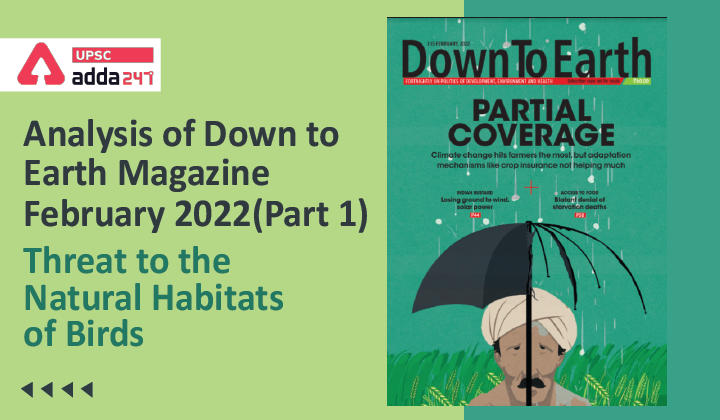Table of Contents
Threat to the Natural Habitats of Birds
Relevance
”GS 3: Conservation, Government Policies & Interventions”
Introduction
- Rajasthan’s state bird, the great Indian bustard (gib), listed under the “critically endangered” category by the International Union for Conservation of Nature in 2011 is under serious danger due to rising solar power stations and windmills in the desert area of Rajasthan.
- In 2018, the Supreme Court ordered that orans, treated as open natural ecosystems, should be declared deemed forests.
- So far there has been no development, and the state government is now welcoming power companies to the sacred groves, damaging gib habitat.
- Owing to the rising number of gib deaths, M K Ranjitsinh Jhala, a wildlife conservationist, filed a petition in the Supreme Court in 2019 urging power companies to lay underground wiring in the gib habitat in Jaisalmer.
- In April 2021, the apex court ordered power firms in Rajasthan to lay underground wiring for all projects and install diverters on existing lines in the region.

- Given their size, any collision with the power lines is fatal. They get electrocuted and die.
- The power lines have formed a web around the gib habitat, leading to a sharp decline in their population in the last few years.
- Many such accidents have occurred since these high-tension wires have been laid.
What are the loopholes?
- Challenging the notion “green is always good”, conservationists insist on looking at solar and wind projects objectively.
- They say situations like the one in Jaisalmer need careful scrutiny and that renewables should not be supported blindly.
- Unlike forests, there are no conservation laws that protect against diversion of biodiversity-rich open natural ecosystems, otherwise termed as wastelands, and governments try to make them “useful and productive” by allowing solar and wind parks on them.
- This is unfortunate as research has shown that under certain environmental conditions, open natural ecosystems can sequester more carbon than if trees were planted on them.
- The value of such ecosystems is being undervalued and the benefits of renewable energy are being overstated.
Green Energy is an Uncontrolled Sector
- If we talk about solar energy, we need to see not only the gains but also the pains.
- In India, renewable energy companies are some of the most unregulated in the world.
- In the US and Europe, wind and solar companies are subject to environmental impact assessments just as any other development project. Large-scale studies are conducted on avian flyways before situating wind farms and power lines.
- In the case of hydroelectricity, the public sector controls over 90 per cent of both installed capacity and power generation. But in the case of solar and wind power, around 95 per cent of it is in the hands of the private sector.
Great Danger to The Great Indian Bustard
- Rajasthan’s state bird, the great Indian bustard (gib), listed under the “critically endangered” category by the International Union for Conservation of Nature in 2011 is under serious danger due rising to solar power stations and windmills in the desert area of Rajasthan.
- Gibs are slow breeders and lay only one egg every year, that too in the wild. The eggs are sometimes destroyed by cattle, or eaten by larger animals.

- It has been well observed that transmission lines and gibs cannot coexist. Even other birds like raptors, floricans, demoiselle cranes and migratory birds get killed because of the power lines.
- Except for the Pokhran field firing range and the Desert Park, there are transmission lines everywhere in the desert area of Rajasthan.
- Even the oran has not been spared. The solar companies have taken up our oran, uprooting native trees and grasses that have not even been documented properly.
What needs to be done?
- The country needs to invest in green energy. But it does not have to be at the cost of biodiversity.
- The advantage of solar energy is that it can be distributed and decentralised.
- The government simply needs to follow its own rooftop solar policy, and modify it to become a “grey-top” solar policy, which means setting rooftops on top of industries and factories that are spread over large spaces.
- Unlike rooftop solar on residences, large industrial spaces generate enough electricity to make economic sense to connect to the grid. Such localised generation and utilisation will also cut transmission losses.
- Rooftops of public buildings can also be used for solar installations, as has been done with railway stations in some cities.
- Agrivoltaics, the practice of using farmland for generating solar power and agriculture simultaneously, as an option to increase the area under renewables.
- Deploying solar panels in a manner that allows for cultivation below them has dual benefits. The shade from the panels reduces evapotranspiration and saves water, and the panels themselves benefit from increased efficiency due to the cooling effect of the plants growing below them.
- The Alliance for Reversal of Ecosystem Service Threats, a project under atree, has identified 11 million hectares of degraded agricultural land in the semi-arid and sub-humid regions of India. If such areas were used for agrivoltaics, it could potentially transform the rural economies of these regions.



 TSPSC Group 1 Question Paper 2024, Downl...
TSPSC Group 1 Question Paper 2024, Downl...
 TSPSC Group 1 Answer key 2024 Out, Downl...
TSPSC Group 1 Answer key 2024 Out, Downl...
 UPSC Prelims 2024 Question Paper, Downlo...
UPSC Prelims 2024 Question Paper, Downlo...
